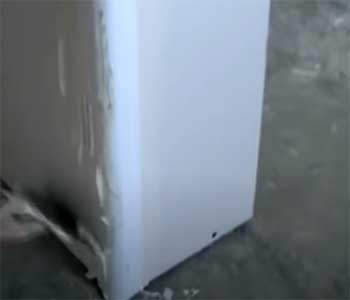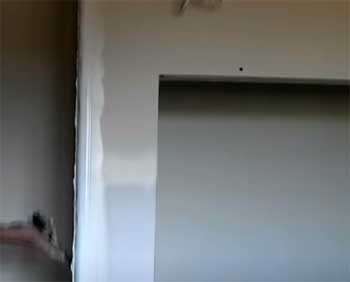When you are building your home, one of the major concerns for you is to decide on the corners. Whether they will be rounded or square can be a crucial decision that you have to make.
But I will not discuss that here, as that’s another topic.
This is an article for those who are interested in rounded corners. I have gathered all the pros and cons of rounded drywall corners for those. This will give you a clear picture of the advantages of having this kind of corner truly.
You also get to know about the drawbacks of making a much more informed decision.
Let’s get on with the whole thing.
Primary Styles of Rounded Drywall Corners

There are a few main styles of rounded drywall corners to choose from:
- Factory-Made Rounded Corner Bead
This style utilizes a specialty corner bead with integrated curves to create the rounded shape. The corner bead gets embedded into joint compound and layered over with drywall to build out the rounded edge.
- Field-Formed Rounded Corners
Field-formed rounded corners are created onsite using drywall only. The edges of the drywall are cut and layered to slowly build out the rounded shape without the need for a corner bead. This takes more time and skill but can provide more customization.
- Factory-Formed Rounded Corners
Pre-formed rounded corners come with the curve already integrated into the drywall itself for fast, simple installation. This style provides clean, uniform rounded edges but allows for less customization onsite.
The Benefits And Drawbacks Of Rounded Drywall Corners
Here’s a table of all the pros and cons you get to experience with rounded drywall corners. This will help you get a basic idea of the whole thing.
| Pros | Cons |
| They are great for a unique appearance | Installing baseboards gets difficult |
| They aren’t prone to chips or fractures | It gets costly at times |
| Softens up the room with fewer edges | Can Show Imperfections |
| It’s quite easy to do rounded corners | Difficult Fixtures and Trim |
| They are suitable for modern homes |
Yes, sure, you get the basic idea, but is it enough to make a decision? Unless the cons are deal-breaking, you have to look for the details to understand the whole thing better.
The Advantages Of Rounded Drywall Corners
First, let’s get an in-depth idea of the advantages of having rounded drywall corners. This will surely give you the whole idea, and you can easily see what benefits you will get from a rounded corner.
- Creates A Unique Appeal At Home
One of the major reasons people go for rounded drywall corners is because of the unique appeal.
When you have rounded corners around your home, it makes your home unique in terms of how it looks. It also provides you with the option to arrange your furniture with ease.
- They Don’t Get Chips Or Fractures

A great thing about rounded drywall corners is the fact that you don’t get fractures or chips around your home.
You get into a room; you surely don’t want to see chips and fractures all around the corners, right?
You would want a clean and smoother-looking surface.
With rounded drywall, you won’t have that issue at all. Whereas the traditional square corners tend to have that problem with fractures and chips.
So, that’s a pretty effective benefit you get for rounded drywall corners over square ones.
- Provides Softer Edges On The Room
Since rounded drywall corners mean softer edges, you can always end up with a smoother-looking room. And honestly, it’s not just about the looks, the feel of the room also changes.
You won’t have any feeling of sharpness around the room.
There is nothing wrong with the square ones; it’s just about preferences. The rounded drywall corners just have a smoother feel and appearance; that’s pretty much it.
- Easy To Create And Workaround
Rounded walls are much easier to construct than other kinds of walls. So, when you get to the building part of this, you will indeed have a better experience building this.
Also, you get to work around the drywall corners much more easily because of the smoother edges.
Well, these are the specific benefits of having rounded drywall corners. As you can tell, they can be a better choice in some cases over square corners.
But where they fall behind is also something to consider. So, let’s take a look at the disadvantages as well.
- Increased Durability
The extra layering of drywall mud and corner bead makes rounded corners more durable and resistant to cracks or damage from bumps. They hide imperfections better than sharp corners over time. Kids and pets are less likely to harm themselves on the curved edges as well.
- Easier to Clean
Rounded corners eliminate the hard-to-reach right angle that can collect dirt, dust, and grime. Their smooth finish allows mop heads, dusters, and cleaning cloths to slide easily over the surface, keeping corners cleaner.
The Disadvantages Of Rounded Drywall Corners
Typically, there are a couple of disadvantages with rounded drywall corners. While they aren’t major ones, they can surely be problematic ones.
Here’s what may bother you about rounded drywall corners –
- It’s Challenging To Install Baseboards With Rounded Drywall Corners

When it’s about installing baseboards on a rounded drywall corner, you will have a much more difficult time.
I mean, the reason is simple. You can get the 90-degree angle with square walls, which makes it super easy to install baseboard.
The surface is a bit smoother with rounded walls, making it hard to fit baseboards on.
- It Can Be A Bit More Costly Than Square Corners
Rounded corners are usually costlier to build than square corners. Square corners don’t require too much material; on the other hand, you will have to use more material with rounded corners.
This is because shaping the material into a rounded corner requires more work and material.
Now, these are issues that only matter if you have any personal problems with them. And these are issues that you just face at the time of building and never again.
So, I don’t think these should bother you too much if you are on board with the advantages.
- Can Show Imperfections
While rounded corners do hide bumps and dents better than angular corners, the curving shapes also highlight any inconsistencies in the curves themselves. Even slight variations in the rounding are quite noticeable and can bother those with discerning eyes.
- Difficult Fixtures and Trim
Light switches, power outlets, door casings, and trim become much trickier with rounded corners. It takes extra care and time to properly cut and fit fixtures into the curving corners.
Frequently Asked Questions (FAQ)
Let’s check out some of the common questions a lot of people have regarding rounded drywall corners –
Rounded corners have come in and out of style over the decades, leaving some homeowners wondering if the look now appears dated. When rounded corners first gained popularity in the 1980s, the completely curved look was trendy and modern. As angular corners dominated the 1990s and early 2000s, some started to view the bullnose look as outdated and too reminiscent of older buildings. However, as interior design tends to be cyclical, rounded corners have come back around as an on-trend look, feeling fresh and current in contemporary open concept spaces. When used in moderation as an accent rather than overwhelming an entire home, rounded drywall corners avoid looking outdated.
Professional interior designers frequently incorporate rounded drywall corners into their open concept designs for several reasons. The curves help spaces feel larger, draw the eye around rooms seamlessly, and softens hard lines. Rounded corners add depth, dimension and a high-end modern look as well. Interior designers also use rounded corners strategically to make small rooms appear larger, open up constricted spaces, highlight architectural details, or create intimate areas within open plans.
Rounded drywall corners go by a few common names including: Bullnose corners, Rounded corners, Curved corners, Radius corners, Soft corners.
All these terms refer to corners that have had the 90-degree angle rounded off to create a softer, curved edge rather than two walls meeting sharply at right angles.
While preferences come down to individual taste and design style goals, some of the most popular choices for drywall corner styles today include:
Basic Square Corners: Simple, classic 90 degree corners remain prevalent for their clean lines and affordability
Rounded Bead Corners: Factory-molded rounded corner beads make achieving smooth radiused corners accessible
Decorative Outside Corners: Outer corners dressed up with crown moldings, trim accents, or decorative beads add depth
Off-Angle Corners: Unique angular corner designs create modern dimension and customization
Shadowline Corners: Recessed inner grooves highlight corners for dramatic contrast
These options provide enough diversity to suit personal style while rounding out interior spaces with dimension, depth, and detail.
Conclusion
In short, the pros and cons of rounded drywall corners are pretty balanced. Whether you choose them or not depends on your personal needs completely.
But if you are looking for corners that won’t fracture or chip, then this is surely the pick for you. But if you want to save money, even a little bit, then go for square corners.
